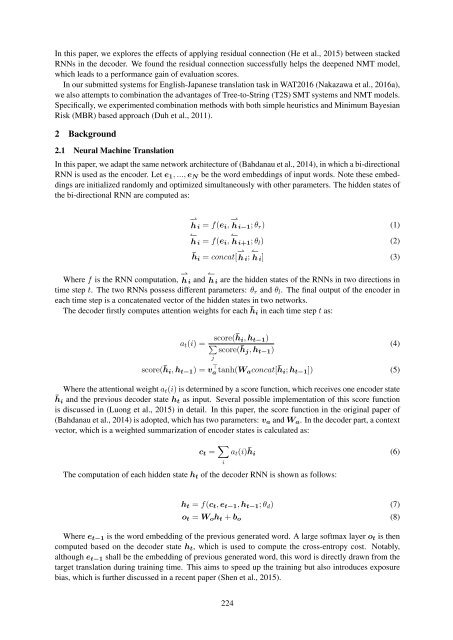December 11-16 2016 Osaka Japan
W16-46
W16-46
Create successful ePaper yourself
Turn your PDF publications into a flip-book with our unique Google optimized e-Paper software.
In this paper, we explores the effects of applying residual connection (He et al., 2015) between stacked<br />
RNNs in the decoder. We found the residual connection successfully helps the deepened NMT model,<br />
which leads to a performance gain of evaluation scores.<br />
In our submitted systems for English-<strong>Japan</strong>ese translation task in WAT20<strong>16</strong> (Nakazawa et al., 20<strong>16</strong>a),<br />
we also attempts to combination the advantages of Tree-to-String (T2S) SMT systems and NMT models.<br />
Specifically, we experimented combination methods with both simple heuristics and Minimum Bayesian<br />
Risk (MBR) based approach (Duh et al., 20<strong>11</strong>).<br />
2 Background<br />
2.1 Neural Machine Translation<br />
In this paper, we adapt the same network architecture of (Bahdanau et al., 2014), in which a bi-directional<br />
RNN is used as the encoder. Let e 1 , ..., e N be the word embeddings of input words. Note these embeddings<br />
are initialized randomly and optimized simultaneously with other parameters. The hidden states of<br />
the bi-directional RNN are computed as:<br />
⇀<br />
h i = f(e i , ⇀ h i−1; θ r ) (1)<br />
↼<br />
h i = f(e i , ↼ h i+1; θ l ) (2)<br />
¯h i = concat[ ⇀ h i; ↼ h i] (3)<br />
Where f is the RNN computation, ⇀ h i and ↼ h i are the hidden states of the RNNs in two directions in<br />
time step t. The two RNNs possess different parameters: θ r and θ l . The final output of the encoder in<br />
each time step is a concatenated vector of the hidden states in two networks.<br />
The decoder firstly computes attention weights for each ¯h i in each time step t as:<br />
a t (i) = score(¯h i , h t−1 )<br />
∑<br />
score(¯h j , h t−1 )<br />
j<br />
score(¯h i , h t−1 ) = v ⊤ a tanh(W a concat[¯h i ; h t−1 ]) (5)<br />
Where the attentional weight a t (i) is determined by a score function, which receives one encoder state<br />
¯h i and the previous decoder state h t as input. Several possible implementation of this score function<br />
is discussed in (Luong et al., 2015) in detail. In this paper, the score function in the original paper of<br />
(Bahdanau et al., 2014) is adopted, which has two parameters: v a and W a . In the decoder part, a context<br />
vector, which is a weighted summarization of encoder states is calculated as:<br />
(4)<br />
c t = ∑ i<br />
a t (i)¯h i (6)<br />
The computation of each hidden state h t of the decoder RNN is shown as follows:<br />
h t = f(c t , e t−1 , h t−1 ; θ d ) (7)<br />
o t = W o h t + b o (8)<br />
Where e t−1 is the word embedding of the previous generated word. A large softmax layer o t is then<br />
computed based on the decoder state h t , which is used to compute the cross-entropy cost. Notably,<br />
although e t−1 shall be the embedding of previous generated word, this word is directly drawn from the<br />
target translation during training time. This aims to speed up the training but also introduces exposure<br />
bias, which is further discussed in a recent paper (Shen et al., 2015).<br />
224



